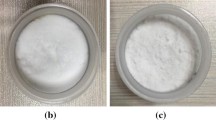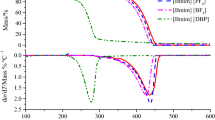Abstract
Nitrocellulose is a highly combustible substance that is extensively utilized in creating a variety of products, making the appropriate handling and storage of this material vital for worker safety. In our analysis, we assessed the dangers associated with nitrocellulose by both numerical and experimental research. We calculated the heat release rate, the time necessary to attain the maximum rate, and the total heat of reaction for nitrocellulose under various conditions using calorimetry and thermokinetic techniques. Our findings demonstrated that the rate of heat release and the total heat of the reaction rose as temperature and concentration increased. In addition, the addition of stabilizers and diluents to the nitrocellulose mixture reduced both the rate of heat release and the total heat of the reaction. The congruence between experimental findings and numerical simulations confirmed the validity of our modeling strategy. Overall, the results of our research give essential information for evaluating the dangers, such as the temperature and activation energy, associated with nitrocellulose and indicate viable solutions for strengthening the material’s safety during handling and long-term storage.











Similar content being viewed by others
Abbreviations
- ∆H d :
-
Heat of decomposition (J g−1)
- A :
-
Frequency factor (1 s−1)
- C :
-
Constant value (dimensionless)
- C s :
-
Constant value of Starink kinetic model (dimensionless)
- E a :
-
Apparent activation energy (kJ mol−1)
- f(α):
-
Differential kinetic function (dimensionless)
- g(α):
-
Integral kinetic function (dimensionless)
- k :
-
Rate constant at infinite temperature
- K :
-
Reaction rate constant (1 min−1)
- M :
-
Mass (%)
- n :
-
Partial orders of reaction (dimensionless)
- N :
-
Sample number (dimensionless)
- R :
-
Universal gas constant (8.314 J (mol × K)−1)
- R 2 :
-
Coefficient of determination (dimensionless)
- SADT:
-
Self-accelerating decomposition temperature (°C)
- t :
-
Time (min)
- T :
-
Absolute temperature (K)
- T 0 :
-
Apparent onset temperature (°C)
- T f :
-
Final reaction temperature (°C)
- T p :
-
Peak temperature (°C)
- α :
-
Conversion degree (dimensionless)
- β :
-
Heating rate (°C min−1)
- γ :
-
Degree of conversion rate (dα dt−1)
References
Sun M, Bennett T, Visintin P. Dataset on plastic and early-age shrinkage of ultra-high performance concrete with corresponding chemical shrinkage, temperature, relative humidity, reaction degree and material properties changes. Data Brief. 2022;42: 108053.
Hernowo P, Steven S, Restiawaty E, Bindar Y. Nature of mathematical model in lignocellulosic biomass pyrolysis process kinetic using volatile state approach. J Taiwan Inst Chem Eng. 2022;139:104520.
Huang A-C, Liao F-C, Huang C-F, Tang Y, Zhang Y, Shu C-M, et al. Calorimetric approach to establishing thermokinetics for cosmeceutical benzoyl peroxides containing metal ions. J Therm Anal Calorim. 2021;144(2):373–82.
Wei R, He Y, Zhang Z, He J, Yuen R, Wang J. Effect of different humectants on the thermal stability and fire hazard of nitrocellulose. J Therm Anal Calorim. 2018;133(3):1291–307.
Chai H, Duan Q, Cao H, Li M, Sun J. Effects of nitrogen content on pyrolysis behavior of nitrocellulose. Fuel. 2020;264:116853.
He Y, He Y, Liu J, Li P, Chen M, Wei R, et al. Experimental study on the thermal decomposition and combustion characteristics of nitrocellulose with different alcohol humectants. J Hazard Mater. 2017;340:202–12.
Zhang J, Ma Y-Y, Chen L-P, Chen W-H. Experimental and numerical simulation to identify the thermal hazards and hazardous scenarios of N-nitrodihydroxyethyl dinitrate. Process Saf Environ Prot. 2021;145:211–21.
Xiong J, Jin B, Yu X-M, Liao L, Peng R-F. Synthesis, crystallographic characterization, and potential application of fullerene anisole derivatives as nitrocellulose stabilizer. Defence Technology; 2022.
Yang Y, Wang X-F, Pan M-Y, Li P, Tsai Y-T. Evaluation on algorithm reliability and efficiency for an image flame detection technology. J Therm Anal Calorimet. 2023;148:5063–70.
Yang Y, Yuan H, Li Z, Tsai Y. Investigation on incompatible hazards of nitrocellulose mixed with three types of copper compounds. J Therm Anal Calorimet. 2023;6:1–8.
Liang L, Luo Q, Xu W, Liang M, Shen H. Effects of several cosolvents and non-solvents on ester true solvents in nitrocellulose lacquer thinner. Progress Organ Coat. 2022;172:107063.
Chai H, Duan Q, Jiang L, Gong L, Chen H, Sun J. Theoretical and experimental study on the effect of nitrogen content on the thermal characteristics of nitrocellulose under low heating rates. Cellulose. 2018;26(2):763–76.
Tang Y, Wu Y, Yang N, Miao C-F, Huang A-C. Thermokinetics and gas emission characteristics of nitrification waste under different oxygen contents by using TG-FTIR technique. Case Stud Therm Eng. 2023;41:102689.
Wei R, Huang S, Wang Z, Wang X, Ding C, Yuen R, et al. Thermal behavior of nitrocellulose with different aging periods. J Therm Anal Calorim. 2018;136(2):651–60.
Lin C-P, Chang Y-M, Gupta JP, Shu C-M. Comparisons of TGA and DSC approaches to evaluate nitrocellulose thermal degradation energy and stabilizer efficiencies. Process Saf Environ Prot. 2010;88(6):413–9.
Chai H, Duan Q, Cao H, Li M, Qi K, Sun J, et al. Experimental study on the effect of storage conditions on thermal stability of nitrocellulose. Appl Therm Eng. 2020;180:115871.
Yang N, Tang Y, Wu H, Shu C-M, Xing Z-X, Jiang J-C, et al. Influence evaluation of ionic liquids on the alteration of nitrification waste for thermal stability. J Loss Prevent Process Ind. 2023;82:104977.
Liang M, Zhang K, Lei P, Wang B, Shu C-M, Li B. Fuel properties and combustion kinetics of hydrochar derived from co-hydrothermal carbonization of tobacco residues and graphene oxide. Biomass Convers Biorefin. 2019;10(1):189–201.
Wang B, Yi H, Xu K, Wang Q. Prediction of the self-accelerating decomposition temperature of organic peroxides using QSPR models. J Therm Anal Calorim. 2016;128(1):399–406.
Pan Y-P, Li N, Yang J-J, Zhu Z-W, Gong J-F, Song M-P. Facile synthesis of NC(sp3)O pincer palladium complexes and their use as efficient catalysts for Suzuki–Miyaura reaction of aryl bromides in aqueous medium. J Organometal Chem. 2021;932:121645.
Alashmawy MM, Hassan HS, Ookawara SA, Elwardany AE. Thermal decomposition characteristics and study of the reaction kinetics of tea-waste. Biomass Convers Biorefin. 2023;6:1–19.
Liu Y, Bai T, Tian Y, Wang Y, Wang J, Wang X, et al. SegDQ: segmentation assisted multi-object tracking with dynamic query-based transformers. Neurocomputing. 2022;481:91–101.
Sidek FN, Saleh S, Abdul Samad NAF. Kinetic parameter estimation for pyrolysis of empty fruit bunch using model-fitting and model-free methods. Mater Today Proc. 2022;57:1241–7.
Wu Z-H, Wu Y, Tang Y, Jiang J-C, Huang A-C. Evaluation of composite flame-retardant electrolyte additives improvement on the safety performance of lithium-ion batteries. Process Saf Environ Prot. 2023;169:285–92.
Tang Y, Li Z-P, Zhou H-L, Miao C-F, Jiang J-C, Huang A-C. Thermal stability assessment of nitrocellulose by using multiple calorimetric techniques and advanced thermokinetics. J Therm Anal Calorim. 2023;148(11):5029–38.
Wei R, Huang S, Huang Q, Ouyang D, Chen Q, Yuen R, et al. Experimental study on the fire characteristics of typical nitrocellulose mixtures using a cone calorimeter. J Therm Anal Calorim. 2018;134(3):1471–80.
Tănase C, Odochian L, Apostolescu N, Pui A. TG–FTIR analysis applied to the study of thermal behaviour of some edible mushrooms. J Therm Anal Calorim. 2010;103(3):1079–85.
Meriste T, Yörük CR, Trikkel A, Kaljuvee T, Kuusik R. TG–FTIR analysis of oxidation kinetics of some solid fuels under oxy-fuel conditions. J Therm Anal Calorim. 2013;114(2):483–9.
Liang X, Cheng Y-C, Lin W-C, Tung P-H, Huang H-Q, Pan X, et al. Analysis and characterisation of 1-butyl-3-methylimidazolium hexafluorophosphate as a humectant of nitrocellulose. J Mol Liq. 2020;303:112617.
Jagtap A, Kalbande SR. Investigation on pyrolysis kinetics and thermodynamic parameters of soybean straw: a comparative study using model-free methods. Biomass Convers Biorefin. 2022;8:1–12.
Gözke G, Açıkalın K. Pyrolysis characteristics and kinetics of sour cherry stalk and flesh via thermogravimetric analysis using isoconversional methods. J Therm Anal Calorim. 2020;146(2):893–910.
Xia Y, Huang Y, Li Y, Liao S, Long Q, Liang J. LaPO4: Ce, Tb, Yb phosphor—synthesis and kinetics study for thermal process of precursor by Vyazovkin, OFW, KAS, Starink, and Mastplosts methods. J Therm Anal Calorim. 2015;120(3):1635–43.
de Freitas-Marques MB, Araujo BCR, da Silva PHR, Fernandes C, Mussel WDN, Sebastião RDCDO, et al. Multilayer perceptron network and Vyazovkin method applied to the non-isothermal kinetic study of the interaction between lumefantrine and molecularly imprinted polymer. J Therm Anal Calorimet. 2020;145(5):2441–9.
Pourbasheer E, Aalizadeh R, Ganjali MR, Norouzi P, Shadmanesh J, Methenitis C. QSAR study of Nav1.7 antagonists by multiple linear regression method based on genetic algorithm (GA–MLR). Med Chem Res. 2013;23(5):2264–76.
Turkyilmazoglu M. Combustion of a solid fuel material at motion. Energy. 2020;203:117837.
Turkyilmazoglu M. Heat transfer from warm water to a moving foot in a footbath. Appl Therm Eng. 2016;98:280–7.
Acknowledgements
This study was supported by the National Key Research Development Program of China (No. 2021YFC3001203), the National Nature Science Foundation of China (No. 21927815), and Postgraduate Research & Practice Innovation Program of Jiangsu Province (No. KYCX21_2878).
Author information
Authors and Affiliations
Corresponding authors
Additional information
Publisher's Note
Springer Nature remains neutral with regard to jurisdictional claims in published maps and institutional affiliations.
Rights and permissions
Springer Nature or its licensor (e.g. a society or other partner) holds exclusive rights to this article under a publishing agreement with the author(s) or other rightsholder(s); author self-archiving of the accepted manuscript version of this article is solely governed by the terms of such publishing agreement and applicable law.
About this article
Cite this article
Wu, Y., Zhou, HL., Jiang, JC. et al. Essential hazard assessment of nitrocellulose via numerical and experimental investigation and calorimetry thermokinetic approaches. J Therm Anal Calorim (2023). https://doi.org/10.1007/s10973-023-12764-3
Received:
Accepted:
Published:
DOI: https://doi.org/10.1007/s10973-023-12764-3




